Bidirectional Electromagnetically Induced Transparency Based on Coupling of Magnetic Dipole Modes in Amorphous Silicon Metasurface
Abstract
1. Introduction
2. Materials and Methods
3. Results and Discussion
3.1. Numerical and Simulated Results
3.2. Experimental Results
4. Conclusions
Author Contributions
Funding
Institutional Review Board Statement
Informed Consent Statement
Data Availability Statement
Acknowledgments
Conflicts of Interest
References
- Hau, L.V.; Harris, S.E.; Dutton, Z.; Behroozi, C.H. Light speed reduction to 17 metres per second in an ultracold atomic gas. Nature 1999, 397, 594–598. [Google Scholar] [CrossRef]
- Fleischhauer, M.; Imamoglu, A.; Marangos, J.P. Electromagnetically induced transparency: Optics in coherent media. Rev. Mod. Phys. 2005, 77, 633–673. [Google Scholar] [CrossRef]
- Jia, F.; Zhang, J.; Zhang, L.; Wang, F.; Mei, J.; Yu, Y.; Zhong, Z.; Xie, F. Frequency stabilization method for transition to a Rydberg state using Zeeman modulation. Appl. Opt. 2020, 59, 2108–2113. [Google Scholar] [CrossRef] [PubMed]
- Wen, Y.; Zhou, P.; Xu, Z.; Yuan, L.; Wang, M.; Wang, S.; Chen, L.; Wang, H.; Shengzhi, W. Cavity-enhanced and long-lived optical memories for two orthogonal polarizations in cold atoms. Opt. Express 2020, 28, 360–368. [Google Scholar] [CrossRef]
- Solomons, Y.; Banerjee, C.; Smartsev, S.; Friedman, J.; Eger, D.; Firstenberg, O.; Davidson, N. Transverse drag of slow light in moving atomic vapor. Opt. Lett. 2020, 45, 3431. [Google Scholar] [CrossRef] [PubMed]
- Wang, T.; Hu, Y.-Q.; Du, C.-G.; Long, G.-L. Multiple EIT and EIA in optical microresonators. Opt. Express 2019, 27, 7344–7353. [Google Scholar] [CrossRef] [PubMed]
- Smith, D.D.; Chang, H.; Fuller, K.A.; Rosenberger, A.; Boyd, R.W. Coupled-resonator-induced transparency. Phys. Rev. A 2004, 69, 063804. [Google Scholar] [CrossRef]
- Xu, Q.; Sandhu, S.; Povinelli, M.L.; Shakya, J.; Fan, S.; Lipson, M. Experimental Realization of an On-Chip All-Optical Analogue to Electromagnetically Induced Transparency. Phys. Rev. Lett. 2006, 96, 123901. [Google Scholar] [CrossRef] [PubMed]
- Jiang, F.; Deng, C.-S.; Lin, Q.; Wang, L.-L. Simulation study on active control of electromagnetically induced transparency analogue in coupled photonic crystal nanobeam cavity-waveguide systems integrated with graphene. Opt. Express 2019, 27, 32122–32134. [Google Scholar] [CrossRef]
- Han, Y.; Yang, J.; He, X.; Huang, J.; Zhang, J.; Chen, D.; Zhang, Z. High quality factor electromagnetically induced transparency-like effect in coupled guided-mode resonant systems. Opt. Express 2019, 27, 7712–7718. [Google Scholar] [CrossRef]
- Tang, H.; Zhou, L.; Xie, J.; Lu, L.; Chen, J. Electromagnetically Induced Transparency in a Silicon Self-Coupled Optical Waveguide. J. Light. Technol. 2018, 36, 2188–2195. [Google Scholar] [CrossRef]
- Lu, H.; Gan, X.; Mao, D.; Zhao, J. Graphene-supported manipulation of surface plasmon polaritons in metallic nanowaveguides. Photon. Res. 2017, 5, 162–167. [Google Scholar] [CrossRef]
- Keleshtery, M.H.; Kaatuzian, H.; Mir, A.; Zandi, A. Method proposing a slow light ring resonator structure coupled with a metal–dielectric–metal waveguide system based on plasmonic induced transparency. Appl. Opt. 2017, 56, 4496–4504. [Google Scholar] [CrossRef]
- Zhang, S.; Genov, D.A.; Wang, Y.; Liu, M.; Zhang, X. Plasmon-Induced Transparency in Metamaterials. Phys. Rev. Lett. 2008, 101, 047401. [Google Scholar] [CrossRef] [PubMed]
- Pitchappa, P.; Manjappa, M.; Ho, C.P.; Singh, R.; Singh, N.; Lee, C. Active Control of Electromagnetically Induced Transparency Analog in Terahertz MEMS Metamaterial. Adv. Opt. Mater. 2016, 4, 541–547. [Google Scholar] [CrossRef]
- Dong, Z.-G.; Liu, H.; Cao, J.-X.; Li, T.; Wang, S.-M.; Zhu, S.-N.; Zhang, X. Enhanced sensing performance by the plasmonic analog of electromagnetically induced transparency in active metamaterials. Appl. Phys. Lett. 2010, 97, 114101. [Google Scholar] [CrossRef]
- Wan, M.; Yuan, S.; Dai, K.; Song, Y.; Zhou, F. Electromagnetically induced transparency in a planar complementary metamaterial and its sensing performance. Optik 2015, 126, 541–544. [Google Scholar] [CrossRef]
- Wan, M.; Song, Y.; Zhang, L.; Zhou, F. Broadband plasmon-induced transparency in terahertz metamaterials via constructive interference of electric and magnetic couplings. Opt. Express 2015, 23, 27361–27368. [Google Scholar] [CrossRef] [PubMed]
- Zhao, Z.; Gu, Z.; Ako, R.T.; Zhao, H.; Sriram, S. Coherently controllable terahertz plasmon-induced transparency using a coupled Fano–Lorentzian metasurface. Opt. Express 2020, 28, 15573–15586. [Google Scholar] [CrossRef]
- Duan, X.; Chen, S.; Cheng, H.; Li, Z.; Tian, J. Dynamically tunable plasmonically induced transparency by planar hybrid metamaterial. Opt. Lett. 2013, 38, 483–485. [Google Scholar] [CrossRef]
- Xiao, B.; Tong, S.; Fyffe, A.; Shi, Z. Tunable electromagnetically induced transparency based on graphene metamaterials. Opt. Express 2020, 28, 4048–4057. [Google Scholar] [CrossRef] [PubMed]
- Sun, C.; Si, J.; Dong, Z.; Deng, X. Tunable multispectral plasmon induced transparency based on graphene metamaterials. Opt. Express 2016, 24, 11466–11474. [Google Scholar] [CrossRef] [PubMed]
- Dong, Z.; Sun, C.; Si, J.; Deng, X. Tunable polarization-independent plasmonically induced transparency based on metal-graphene metasurface. Opt. Express 2017, 25, 12251–12259. [Google Scholar] [CrossRef] [PubMed]
- Sun, C.; Dong, Z.; Si, J.; Deng, X. Independently tunable dual-band plasmonically induced transparency based on hybrid metal-graphene metamaterials at mid-infrared frequencies. Opt. Express 2017, 25, 1242. [Google Scholar] [CrossRef]
- Lao, C.; Liang, Y.; Wang, X.; Fan, H.; Wang, F.; Meng, H.; Guo, J.; Liu, H.; Wei, Z. Dynamically Tunable Resonant Strength in Electromagnetically Induced Transparency (EIT) Analogue by Hybrid Metal-Graphene Metamaterials. Nanomaterials 2019, 9, 171. [Google Scholar] [CrossRef]
- Sun, G.; Peng, S.; Zhang, X.; Zhu, Y. Switchable Electromagnetically Induced Transparency with Toroidal Mode in a Graphene-Loaded All-Dielectric Metasurface. Nanomaterials 2020, 10, 1064. [Google Scholar] [CrossRef]
- Zhang, F.; Zhao, Q.; Zhou, J.; Wang, S. Polarization and incidence insensitive dielectric electromagnetically induced transparency metamaterial. Opt. Express 2013, 21, 19675–19680. [Google Scholar] [CrossRef]
- Wang, Q.; Yu, L.; Gao, H.; Chu, S.; Peng, W. Electromagnetically induced transparency in an all-dielectric nano-metamaterial for slow light application. Opt. Express 2019, 27, 35012–35026. [Google Scholar] [CrossRef]
- Hu, J.; Lang, T.; Hong, Z.; Shen, C.; Shi, G. Comparison of Electromagnetically Induced Transparency Performance in Metallic and All-Dielectric Metamaterials. J. Light. Technol. 2018, 36, 2083–2093. [Google Scholar] [CrossRef]
- Han, B.; Li, X.; Sui, C.; Diao, J.; Jing, X.; Hong, Z. Analog of electromagnetically induced transparency in an E-shaped all-dielectric metasurface based on toroidal dipolar response. Opt. Mater. Express 2018, 8, 2197–2207. [Google Scholar] [CrossRef]
- Ma, T.; Huang, Q.; He, H.; Zhao, Y.; Lin, X.; Lu, Y. All-dielectric metamaterial analogue of electromagnetically induced transparency and its sensing application in terahertz range. Opt. Express 2019, 27, 16624–16634. [Google Scholar] [CrossRef]
- Zhu, L.; Zhao, X.; Miao, F.J.; Ghosh, B.K.; Dong, L.; Tao, B.R.; Meng, F.Y.; Li, W.N. Dual-band polarization convertor based on electromagnetically induced transparency (EIT) effect in all-dielectric metamaterial. Opt. Express 2019, 27, 12163–12170. [Google Scholar] [CrossRef]
- Zhang, Z.; Yang, J.; Bai, W.; Han, Y.; He, X.; Huang, J.; Chen, D.; Xu, S.; Xie, W. All-optical switch and logic gates based on hybrid silicon-Ge2Sb2Te5 metasurfaces. Appl. Opt. 2019, 58, 7392–7396. [Google Scholar] [CrossRef]
- Petronijevic, E.; Sibilia, C. All-optical tuning of EIT-like dielectric metasurfaces by means of chalcogenide phase change materials. Opt. Express 2016, 24, 30411–30420. [Google Scholar] [CrossRef]
- Wei, Z.; Li, X.; Zhong, N.; Tan, X.; Zhang, X.; Liu, H.; Meng, H.; Liang, R. Analogue Electromagnetically Induced Transparency Based on Low-loss Metamaterial and its Application in Nanosensor and Slow-light Device. Plasmonics 2017, 12, 641–647. [Google Scholar] [CrossRef]
- Yang, Y.; Kravchenko, I.I.; Briggs, D.P.; Valentine, J. All-dielectric metasurface analogue of electromagnetically induced transparency. Nat. Commun. 2014, 5, 5753. [Google Scholar] [CrossRef] [PubMed]
- Liu, H.; Guo, C.; Vampa, G.; Zhang, J.L.; Sarmiento, T.; Xiao, M.; Bucksbaum, P.H.; Vučković, J.; Fan, S.; Reis, D.A. Enhanced high-harmonic generation from an all-dielectric metasurface. Nat. Phys. 2018, 14, 1006–1010. [Google Scholar] [CrossRef]
- Zhang, J.; Liu, W.; Yuan, X.; Qin, S. Electromagnetically induced transparency-like optical responses in all-dielectric metamaterials. J. Opt. 2014, 16, 125102. [Google Scholar] [CrossRef]
- Länk, N.O.; Verre, R.; Johansson, P.; Käll, M. Large-Scale Silicon Nanophotonic Metasurfaces with Polarization Independent Near-Perfect Absorption. Nano Lett. 2017, 17, 3054–3060. [Google Scholar] [CrossRef] [PubMed]
- Evlyukhin, A.B.; Reinhardt, C.; Chichkov, B. Multipole light scattering by nonspherical nanoparticles in the discrete dipole approximation. Phys. Rev. B 2011, 84, 235429. [Google Scholar] [CrossRef]
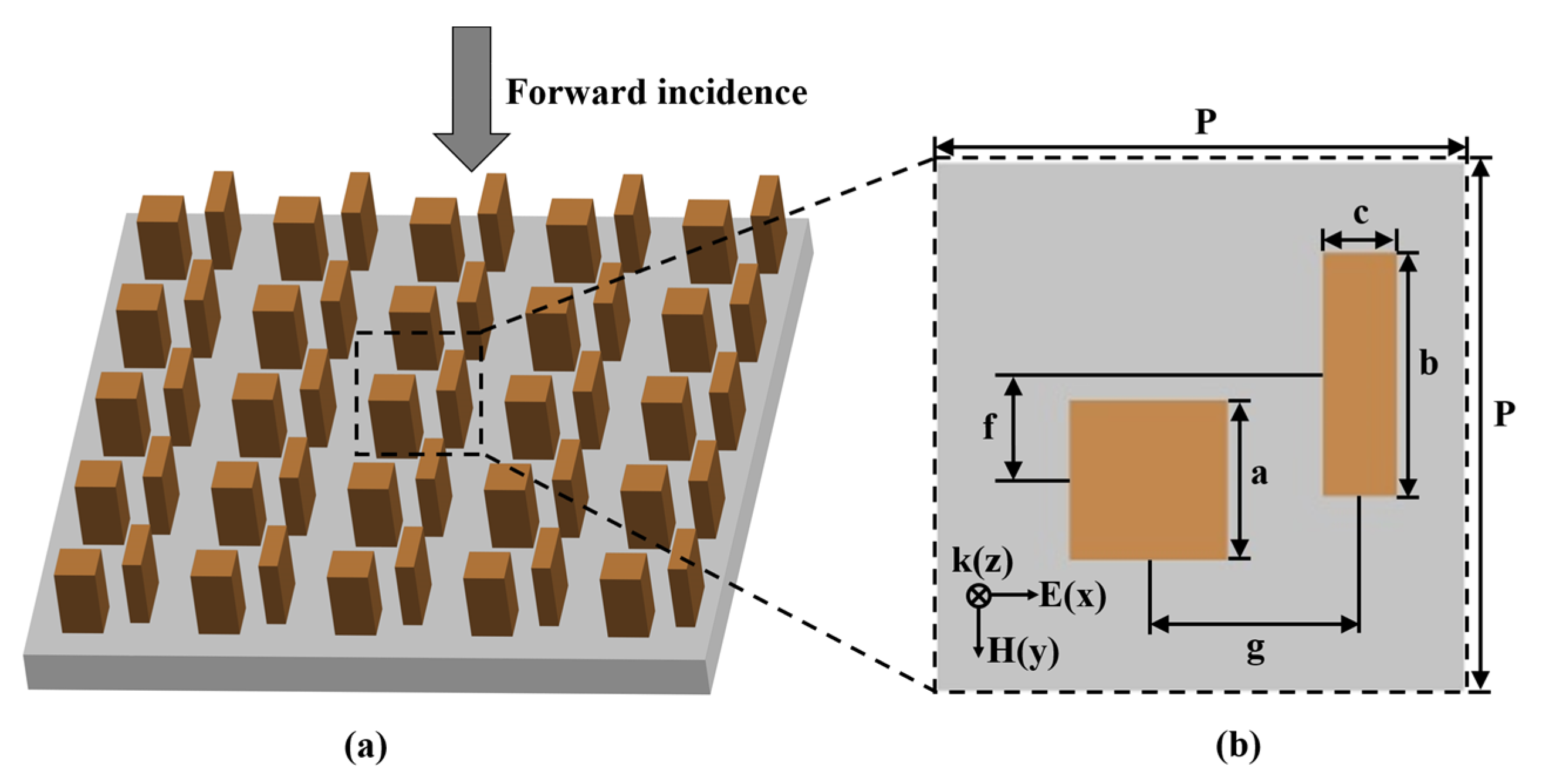
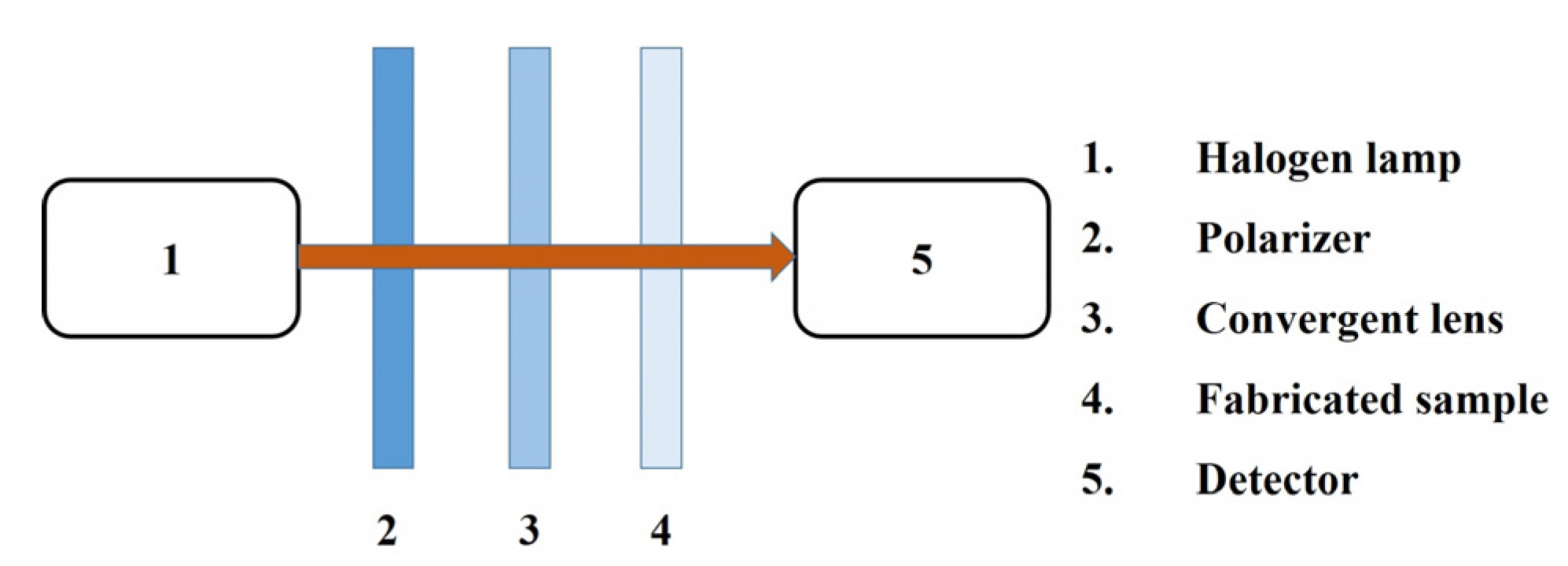
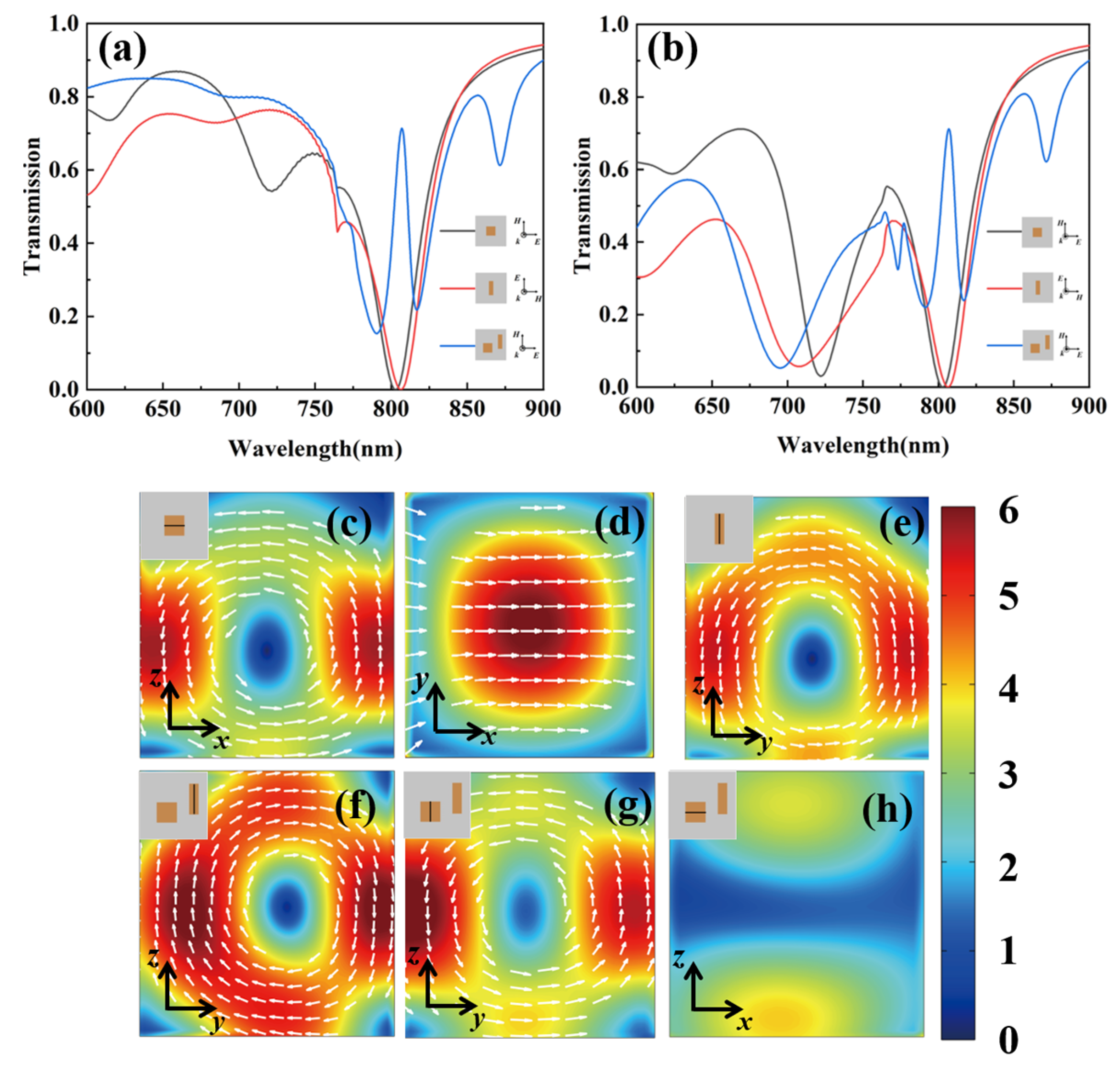
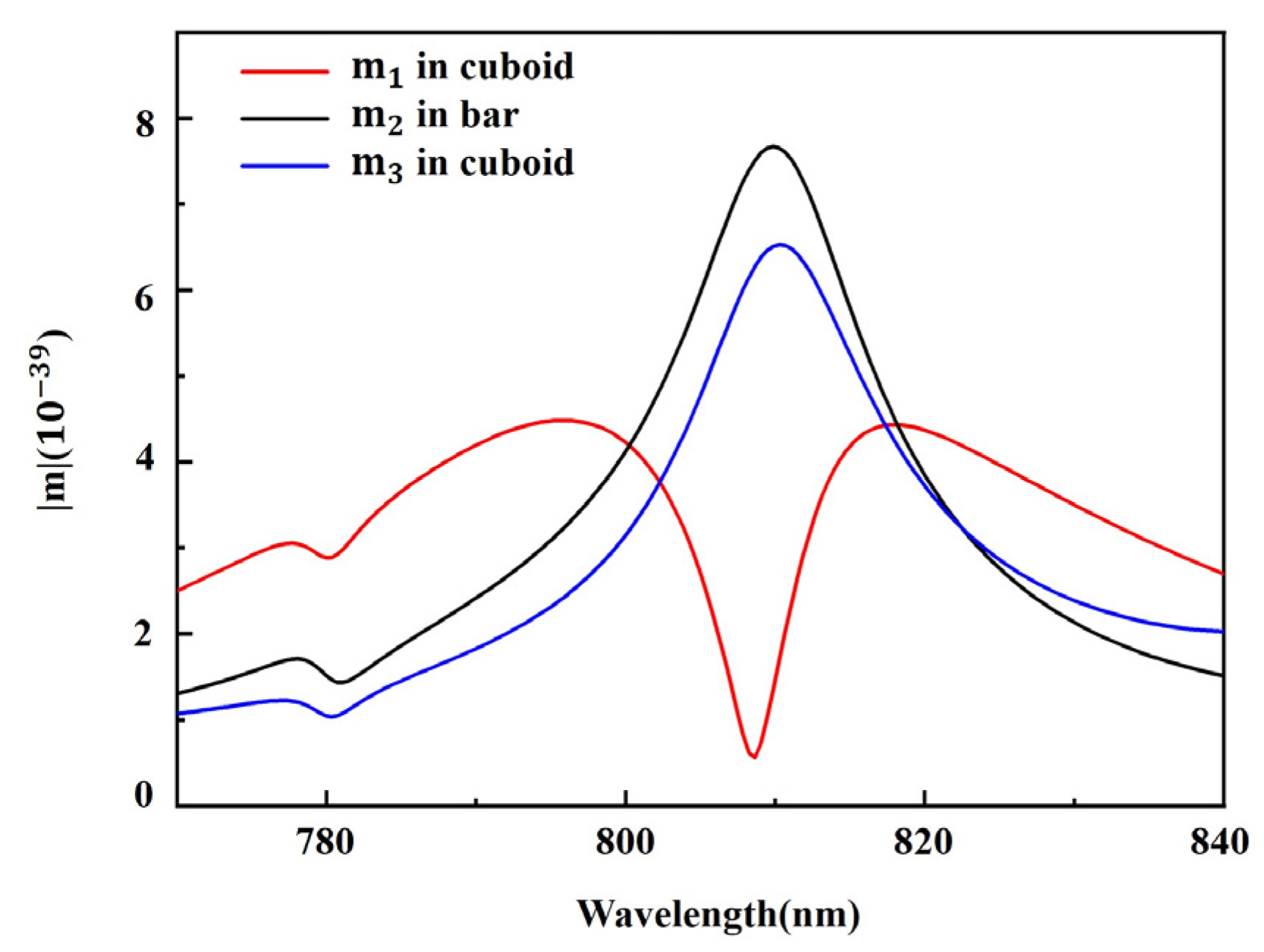

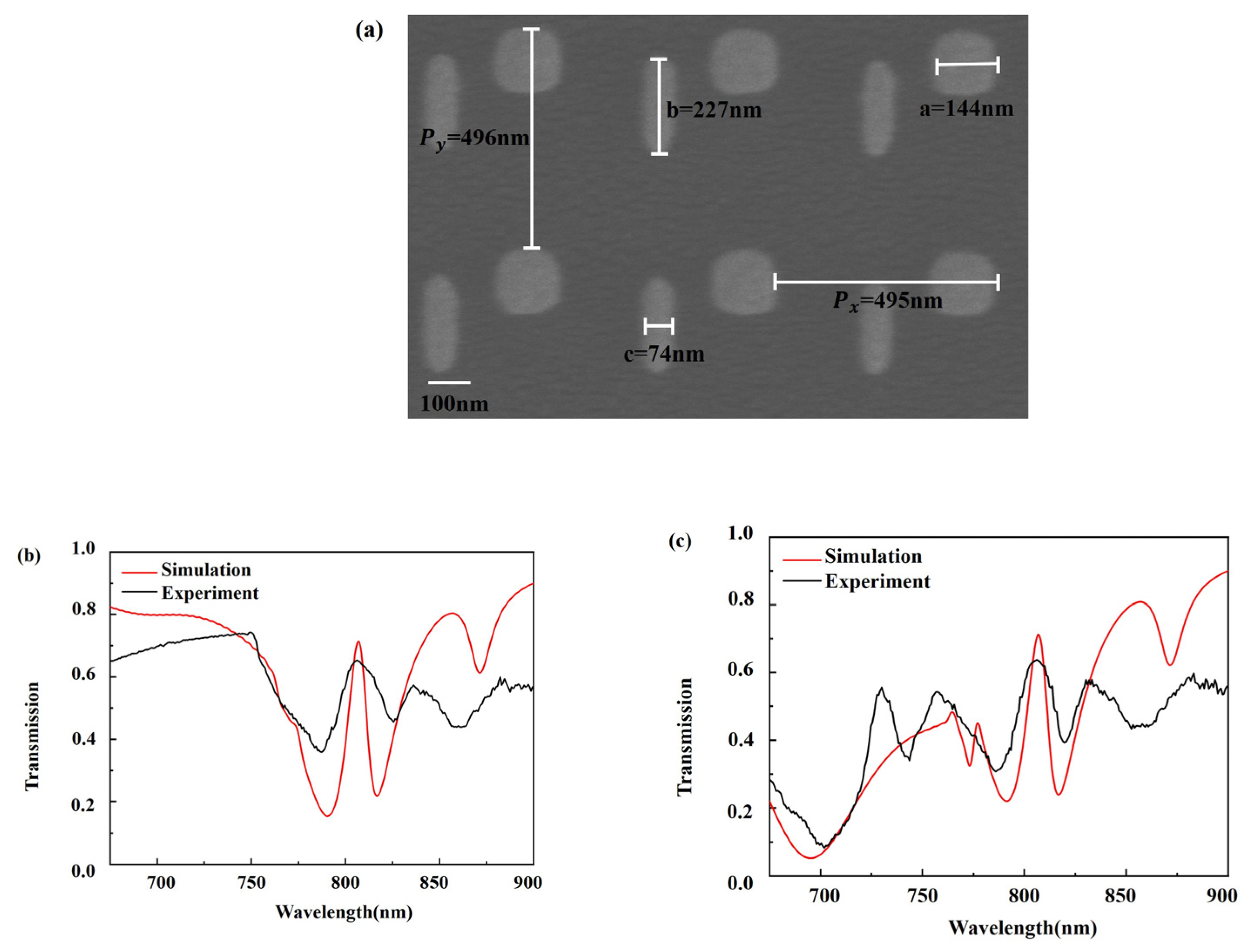
Publisher’s Note: MDPI stays neutral with regard to jurisdictional claims in published maps and institutional affiliations. |
© 2021 by the authors. Licensee MDPI, Basel, Switzerland. This article is an open access article distributed under the terms and conditions of the Creative Commons Attribution (CC BY) license (https://creativecommons.org/licenses/by/4.0/).
Share and Cite
Liu, S.; Dong, J.; Si, J.; Yang, W.; Yu, X.; Zhang, J.; Deng, X. Bidirectional Electromagnetically Induced Transparency Based on Coupling of Magnetic Dipole Modes in Amorphous Silicon Metasurface. Nanomaterials 2021, 11, 1550. https://doi.org/10.3390/nano11061550
Liu S, Dong J, Si J, Yang W, Yu X, Zhang J, Deng X. Bidirectional Electromagnetically Induced Transparency Based on Coupling of Magnetic Dipole Modes in Amorphous Silicon Metasurface. Nanomaterials. 2021; 11(6):1550. https://doi.org/10.3390/nano11061550
Chicago/Turabian StyleLiu, Shuang, Jingxin Dong, Jiangnan Si, Weiji Yang, Xuanyi Yu, Jialin Zhang, and Xiaoxu Deng. 2021. "Bidirectional Electromagnetically Induced Transparency Based on Coupling of Magnetic Dipole Modes in Amorphous Silicon Metasurface" Nanomaterials 11, no. 6: 1550. https://doi.org/10.3390/nano11061550
APA StyleLiu, S., Dong, J., Si, J., Yang, W., Yu, X., Zhang, J., & Deng, X. (2021). Bidirectional Electromagnetically Induced Transparency Based on Coupling of Magnetic Dipole Modes in Amorphous Silicon Metasurface. Nanomaterials, 11(6), 1550. https://doi.org/10.3390/nano11061550





